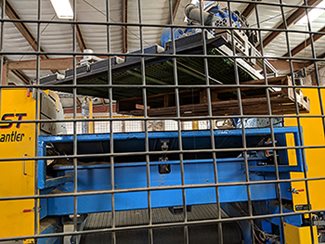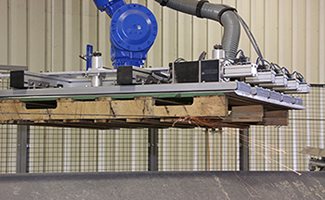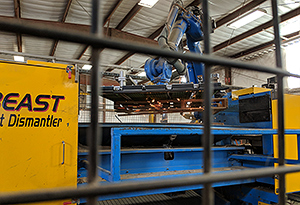 C.L. McKinney’s pioneering mindset of expansion through innovation continues to permeate the corporate culture of the privately held McVantage Group today. Founded by McKinney, a Korean War veteran, in 1953 as a small sawmill (McKinney Lumber, Inc.) in Tuscumbia, Alabama, McVantage Group is a leading manufacturer of wooden packaging products, an international supplier of exotic hardwoods and softwoods, and a developer of sustainable forestry practices and multiuse resources.
C.L. McKinney’s pioneering mindset of expansion through innovation continues to permeate the corporate culture of the privately held McVantage Group today. Founded by McKinney, a Korean War veteran, in 1953 as a small sawmill (McKinney Lumber, Inc.) in Tuscumbia, Alabama, McVantage Group is a leading manufacturer of wooden packaging products, an international supplier of exotic hardwoods and softwoods, and a developer of sustainable forestry practices and multiuse resources.
The first sawmill in the Mid-South to use electricity to remove manual labor out of processing, McVantage Group thrives on futuristic thinking and trendsetting innovation. From the implementation of the region’s first forklift for handling logs to the utilization of the first multi-head super thin kerf bandsaw in the region, leading with cutting-edge technology is at the core of every decision.
Each challenged in the 1970’s by their father to improve company operations, C.L.’s three sons individually set out to innovate with the intent of doubling the family business. During that time, the company expanded into other divisions, such as wooden pallets and treated lumber. Later, when the industry started to change with the push for environmental stewardship, the business expanded into recycled pallets, maximizing products while minimizing the use of forest resources.
Today, a key part of McVantage Group operations is the wooden packaging division. With over four generations of wood industry knowledge in the wood packaging space, McVantage Packaging specializes in the manufacture, repair and recycling of wooden pallets and crates, servicing the Central-Southeastern United States from two plants – Tuscumbia, Alabama and Nashville, Tennessee.
While the Tuscumbia headquarters includes a scragg mill and various production stations for the manufacture and reprocessing of lumber products and packaging, both locations can assemble state-of-the-art pallets, crates and other wooden products compatible with all ISPM 15 standards, guaranteeing quality wood products that can be shipped confidently and safely around the world.
The proven industry leader’s established process for the disassembly of wooden pallets (ranging from standard 48” x 40” GMA pallets to other various sizes) for lumber reclamation entailed one to two skilled workers per station utilizing bandsaws. Between the Tuscumbia and Nashville plant locations, there were a total of seven stations, where the dangerous, deafening and draining manual process for dismantling pallets took place. Over time, this noisy and labor-intensive process made it difficult for McVantage Packaging to retain manual workers to meet year-round production demands, making the existing production process unreliable
With plans already in place to retool the Tuscumbia, Alabama facility in 2015, Joe McKinney, McVantage Managing Director and son of C.L. McKinney, decided the timing was right to revive the McKinney pioneering ways, and he eagerly sought robotic automation for the application of wooden pallet disassembly. With nearly two billion wooden pallets in circulation in the United States1, with the majority of them being replaced each year to maintain the nation’s supply chain2, the need for a reliable robotic dismantling process in line with environmental stewardship goals was well overdue.
The technology McVantage Packaging needed on the shop floor, however, remained undeveloped, motivating the McVantage team to formulate a plan for the first-of-its-kind robotic bandsaw for the disassembly of wooden pallets. With pioneering persistence, Joe and other decision makers presented the innovative idea to multiple robotic integrators, only to be told by each one that the system design envisioned was too complex to build, program and integrate.
Solution
 Using these dismissals as motivation, the McVantage Group persevered, committing to find a robotic integrator that could help. In 2015, after an extensive search, Alliance Automation (Van Wert, Ohio), a Yaskawa Motoman qualified integration partner, agreed to the challenge of building the very intuitive machine that McVantage Packaging had in mind.
Using these dismissals as motivation, the McVantage Group persevered, committing to find a robotic integrator that could help. In 2015, after an extensive search, Alliance Automation (Van Wert, Ohio), a Yaskawa Motoman qualified integration partner, agreed to the challenge of building the very intuitive machine that McVantage Packaging had in mind.
Because element exposure causes wooden pallets to change size over time, system builders and programmers had to plan for a plethora of pallet variances that could arise, tasking the highly-skilled team of engineers at Alliance Automation with the most complicated programming ever. By the fall of 2017 the most intuitive robotic system in the wood pallet industry was ready for the factory floor, and after several months of ramp-up time, McVantage Packaging implemented the consistent (45-hours per week) use of their groundbreaking system at the Tuscumbia, Alabama location.
Equipped with a powerful, efficient six-axis Yaskawa Motoman® MH225 handling robot, featuring high-rigidity speed reducers for extremely fast cycle time and a 225-kg payload capacity for application flexibility, the robotic solution delivered the reliability needed. Built to imitate a human worker’s motion during the sawing process – namely picking up a pallet and moving it through a horizontal bandsaw – the innovative dismantling solution was outfitted with a custom designed vacuum-pad style gripper and a proprietary real-time feedback control loop between the saw motor load and the robot movement. The final solution, respectfully called, “the beast” by the McVantage team, was developed by Alliance Automation and took nearly 24 months to complete.
The MH225 robot reach, repeatability and high payload help facilitate a flexible yet accurate operation, while the “brains” of the operation, the Yaskawa DX200 robot controller, optimizes process capability and manages all aspects of the dismantling operation. The DX200 is also tied into the total workcell’s safety logic system, providing the utmost protection for worker safety.
Results
 Now, with a more streamlined process, McVantage Packaging is increasing yield and decreasing waste. This entire sequence starts with stacked pallets of various dimensions being loaded on the dismantling system infeed station without being presorted by size or style. The pallet stack is then automatically tipped, singulated and transported via a chain driven live roller conveyor (CDLR) through a sophisticated sensor-based measurement system that tells the robot dimensional information about the next pallet it will pick-up for processing. When ready, the robot will subsequently pick that pallet, and on-the-fly run it though additional safety sensors for final validation.
Now, with a more streamlined process, McVantage Packaging is increasing yield and decreasing waste. This entire sequence starts with stacked pallets of various dimensions being loaded on the dismantling system infeed station without being presorted by size or style. The pallet stack is then automatically tipped, singulated and transported via a chain driven live roller conveyor (CDLR) through a sophisticated sensor-based measurement system that tells the robot dimensional information about the next pallet it will pick-up for processing. When ready, the robot will subsequently pick that pallet, and on-the-fly run it though additional safety sensors for final validation.
Once the pertinent information is acquired, the robot moves the pallet through the saw with formula- based motion scripts. The first cut is at the seam between the stringers and bottom boards, allowing them to fall to the exit conveyor. The second cut removes the stringers. Finally, the robot drops off any remaining top board pieces and starts the process over.
Two system operators (a push button operator and an overseer of the disassembled wood), plus a fork lift operator are now used to manage McVantage Packaging’s streamlined process. This is a significant change from the prior situation, where multiple stations were used throughout two locations. While the system is not doing much more, as it mimics human motion, it is highly reliable because it is performing a dull, dangerous and dirty job that is hard to fill.
Similarly, the cost per piece is comparable to the prior process, but the lack of labor issues and the ability to redeploy workers to less physically demanding duties within the company has been beneficial as well. This cost/benefit equation becomes more favorable when the robot system is operational two or three shifts vs. one.
“The robotic pallet disassembly system has allowed us to utilize more recycled lumber, in order to provide quality product at a highly competitive price,” said McVantage Packaging, LLC President, Eddie Daniel. “The reliability and dependability of the robot has greatly increased recycling capabilities and has boosted production; all the while, providing a more ergonomic work environment for employees.
While the robotic solution is still relatively new, decision makers are planning on adding another shift to the system’s workload. The initial cycle time goal was 60 seconds, but thanks to knowledgeable robot programming, combined with sawmill knowledge, McVantage Packaging workers have been able to adjust parameters, getting the cycle time to an impressive 30 seconds, producing more reusable wood.
According to Joe McKinney, installing the robotic dismantling solution for wood pallet disassembly into the Tuscumbia plant was a “huge adjustment,” but the hard working and talented McVantage team, trained by Alliance Automation experts, has maintained the high level of productivity expected, making implementation well worth it.
Full case study article originally published in Pallet Central.